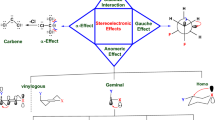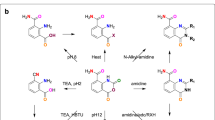Abstract
NOVEL substitution and elimination reactions were noted when 1-nitroanthraquinone-2-carboxamide (I), m.p. 315°, was refluxed with excess of cyclohexylamine alone for 16 h; the products were separated and purified by chromatography in benzene on alumina. Thus, in addition to the expected bluish-red 1-cyclohexylaminoanthra-quinone-2-carboxamide (II) (38 per cent yield), m.p. 223°, formed by replacement of the labile nitro group, three other compounds were separated: in order of increasing adsorption the red 1-cyclohexylaminoanthra-quinone (III) (3.5 per cent), m.p. 145°–146°, formed by elimination of the carboxamide group, the orange 1-aminoanthraquinone-2-cyclohexylcarboxamide (IV) (4.7 per cent) m.p. 289°–290°, suggesting the reducing action of cyclohexylamine and the blue l,4-bis-cyclohexylamino-anthraquinone-2-carboxamide (V) (4.4 per cent), m.p. 276°. Mixed m.p. determinations and thin-plate Keiselgel chromatography of these three compounds with the appropriate authentic synthesized samples confirmed their identity. 1-Cyclohexylammoanthraquinone-2-cyclo-hexylcarboxamide, m.p. 174°–175°, was not isolated from the reaction products.
This is a preview of subscription content, access via your institution
Access options
Subscribe to this journal
Receive 51 print issues and online access
$199.00 per year
only $3.90 per issue
Buy this article
- Purchase on Springer Link
- Instant access to full article PDF
Prices may be subject to local taxes which are calculated during checkout
Similar content being viewed by others
Author information
Authors and Affiliations
Rights and permissions
About this article
Cite this article
HARGREAVES, T., PETERS, A. Novel Reactions in the Anthraquinone Series. Nature 202, 1209–1210 (1964). https://doi.org/10.1038/2021209a0
Issue Date:
DOI: https://doi.org/10.1038/2021209a0
Comments
By submitting a comment you agree to abide by our Terms and Community Guidelines. If you find something abusive or that does not comply with our terms or guidelines please flag it as inappropriate.



